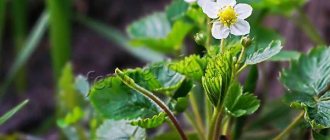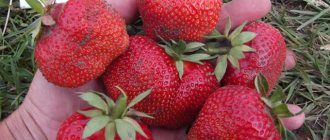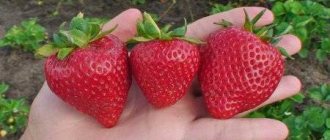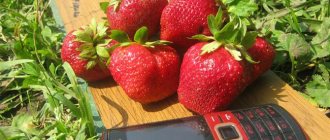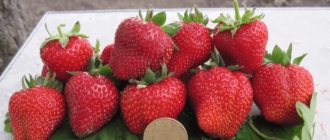Russian gardeners are familiar with Kimberly strawberries relatively recently, but have managed to appreciate the excellent taste of the berries, the yield and hardiness of this Dutch variety from the series under the Vima trademark, which includes several other popular varieties: Rina, Tarda ", "Xima" and "Zanta". Strawberries "Vima Kimberly" are distinguished by medium-early fruiting and rapid ripening, high marketability and the versatility of the culinary purpose of the fruit.
Due to the high yield and marketability of the berries, Wima Kimberly strawberries are excellent for both amateur gardening and commercial cultivation
The variety has proven itself well in the European berry market and has become widespread in the post-Soviet countries as suitable for amateur cultivation and commercial production. Let us consider in detail how the characteristics of the Kimberly strawberry differ, which provided it with well-deserved popularity and numerous laudatory reviews from gardeners.
Main characteristics
| Parameter | Characteristic |
| Culture | Strawberries |
| Ripening period | Mid-early |
| Fruiting | One-time (non-repairable), friendly, short-term (2-3 weeks) |
| Photoperiodic type | Short daylight hours |
| Productivity | High: more than 150 c/ha in open ground, up to 2 kg per bush |
| Mass of berries | Average 20-35 g, maximum up to 50 g |
| Fruit shape | Regular conical, without neck |
| Berry color | Orange-red or scarlet |
| Pulp | Red (orange-red), juicy, dense, without voids |
| Tasting assessment | 4.8-5 points (out of 5) |
| Purpose | Universal |
| Flowers | Large, white, bisexual, rich in pollen |
| Educational ability | Medium (mustache thick, green or red) |
| Sustainability | High winter hardiness, heat and drought resistance; not susceptible to powdery mildew, tolerant to gray rot |
| Productive life cycle | 3-5 years |
| Region of admission | Central and Central Black Earth Russian Federation, all regions of Belarus, north-west and center of Ukraine |
| Year of inclusion in the Federal State Budgetary Institution "State Varietation Commission" | 2013 |
| Originator | Vissers Aardbeiplanten BV (Holland) |
Strawberry propagation methods
The hybrid is propagated using the same methods as other types of garden strawberries:
- vegetative (mustaches);
- seed (through seedlings);
- dividing the bush.
The most reliable way to obtain young varietal plants is vegetative. Kimberley strawberries produce a small number of large tendrils, which, when planted sparsely, can be rooted between rows without moving the plant to another bed.
When propagated by seed, a loss of some qualities is possible due to the transfer of pollen from other varieties. Therefore, planting material should be purchased in specialized stores.
Origin and growing regions
The variety was bred and patented by breeders (Holland), obtained by crossing the Gorella and Chandler lines and combined the best parental qualities. It was included in the State Registers of plants officially approved for cultivation in Belarus (in 2009), Ukraine (in 2011) and Russia (in 2013).
Strawberry "Vima Kimberly" (pictured) is adapted to unfavorable weather conditions, winters safely and bears fruit consistently in the open ground
"Kimberly" has ecological plasticity, is winter-hardy, well adapted to various types of soils (natural zones of mixed forests and forest-steppe) and unfavorable weather conditions (heat, drought) of a temperate continental climate. It is successfully grown in open ground in the Central and Central Black Earth regions of the Russian Federation, throughout Belarus, in the northwestern and central regions of Ukraine. The potential of the variety is even higher when cultivated in protected soil: under film covers or in greenhouses.
Strawberry variety Vima Kimberly: caramel aroma and high yield
Gardeners around the world especially appreciate the opportunity to enjoy the fruits as early as possible in varieties of berry crops. Among Russian summer residents, the love for varieties with early ripening periods, such as Kimberley strawberries, is even more pronounced. Fruiting of late varieties in many areas occurs in cold, rainy weather, and the taste of the berries decreases. Remontant varieties even go away bearing fruit under the snow, without having time to yield a significant part of the harvest.
Description
In terms of ripening time, the variety is considered mid-early; it begins to bear fruit from the end of May (under favorable conditions) or the beginning of June, several days earlier than Elsanta. The berries ripen quickly over a short period of time - 2-3 weeks. The harvest is obtained once per season (non-repairing).
The harvest ripens together, the berries have an even (in size and color) presentation
The bushes are powerful, vigorous, spreading or semi-spreading, but compact and medium leafy. The leaves are large, with sharp, wide teeth along the edges, light green in color, wrinkled and ribbed, bubbly, concave, without shine or pubescence. The middle lobe of the leaf is rhombic, the stipules are wide and pink. The flowers are large, with white petals, bisexual, very rich in pollen, so they are easily and quickly pollinated. Multi-flowered spreading inflorescences are formed on thick, sparsely pubescent, long (located at the level of the leaves) peduncles.
Large white flowers are well pollinated due to the large amount of pollen and their location at leaf level
Warping of medium intensity. The mustache can be green or red in color; they grow in an amount that allows the variety to be propagated by daughter rosettes without any problems. The stalks are quite long and thick, the calyxes are large, pubescent, and consist of simple sepals bent upward.
Berries
The berries are large, almost the same size (they do not shrink towards the end of fruiting), with an average weight of 20-35 g (maximum up to 50 g), and have a beautiful, regular heart-shaped or conical shape without a neck.
Strawberries "Vima Kimberly" (pictured) are distinguished by their uniform size and regular conical shape without a neck
The color of ripe berries is orange-red or scarlet, with a glossy sheen. The pulp is slightly lighter, juicy, dense (meaty), without internal voids. The seeds are few, yellowish, shallowly embedded in the pulp. The taste is sweet with a caramel tint and slight sourness, the aroma is pronounced. The sugar content is 10%, tasting scores for fresh berries are 4.8-5 points (out of 5).
Sweetness (percentage of sugars) depends on the amount of sunlight and heat during fruit ripening.
The variety is universal in purpose; the berries are excellent for fresh consumption, preparation and decoration of various desserts, all methods of processing, and freezing. Thanks to their dense texture, they tolerate transportation and storage well. The excellent taste and commercial qualities of the fruit can be called the main advantages of the variety.
Productivity
The variety is considered very promising, since its yield can exceed 150 c/ha. During state tests conducted in Belarus, the average yield was 68.4 c/ha, and the maximum was 152.8 c/ha (obtained at the Slutsk fruit and berry state plant in 2007).
According to reviews, Vima Kimberly strawberries demonstrate high productivity, especially in the 2-3rd year (up to 1-2 kg of berries per bush) even in Siberia and the Urals
Sustainability
The variety’s hardiness in unfavorable weather conditions (heat and drought), winter hardiness (up to −18 ℃) and its resistance to diseases deserve special attention:
- powdery mildew;
- gray rot (high tolerance);
- fungal spots.
However, the plants are susceptible to anthracnose and the berries can be damaged by insect pests: weevils, slugs, ants, wasps, etc.
Harvesting
In the first summer after planting, the harvest will be small, literally a few berries on each bush. In the 2-3rd year of cultivation, the peak yield occurs. The berries are harvested as soon as they turn red. You should not delay picking, as the color develops very quickly, and overripe berries quickly deteriorate. In addition, under the heavy weight of the fruit, the bush begins to bend over, and the fruits lie on the ground.
The harvested crop is immediately used for preparing preparations or eaten. The berries can be stored in the refrigerator for no more than a week. Under no circumstances should fruits be washed before storage, otherwise they will quickly become unusable and moldy.
Necessary agricultural technology
There are no particular difficulties in caring for Kimberly strawberry plantings. It remains necessary to remove weeds, loosen the soil, fertilize, preventive protective treatments, and constantly remove excess tendrils not intended for reproduction.
Strawberries "Vima Kimberly" are easy to propagate by mustaches (daughter rosettes), but for primary planting it is better to purchase high-quality seedlings from trusted producers
This variety is very sensitive to lack of moisture and prefers daily, fairly abundant watering, especially during hot dry periods and at the initial stage of the growing season. Even with excess moisture in rainy years, the berries do not become watery and less sweet. For planting, you should choose flat areas, well-lit by the sun, with loose, fertile (pre-fertilized) soil.
The best predecessors for strawberries are: legumes, parsley, garlic, radishes, mustard; unsuitable - tomatoes, potatoes, cucumbers, cabbage, sunflowers.
It is preferable to plant seedlings in early spring or early autumn, in cloudy weather. In order not to thicken the planting, the distance between the bushes is left at least 35 cm. Plants of this variety can easily tolerate winter cold, but for reliability it is recommended to cover them with coniferous spruce branches, which retain snow and protect the strawberry root system from freezing.
Proper care
Caring for Kimberly is practically no different from caring for other strawberry varieties and consists of:
- regular watering;
- mulching the soil;
- mustache trimming.
Water the berries once a week in spring. With the onset of summer, watering is increased to 2-3 times a week. Before each watering, make sure that the soil is thoroughly dry, and only then water. The water should not be cold, but at room temperature. A drip irrigation system is ideal for berries - it involves minimal water consumption, and the moisture goes directly to the roots.
After watering, mulch the soil to retain moisture. Manure, peat or sawdust work well as mulch. Mulch protects the root system from hypothermia and bright sunlight.
Important! After each watering, the mulch layer needs to be changed.
In the second and third years of growing, Kimberly produces a lot of whiskers. If there is a desire to propagate the berry, then the mustache is rooted. Over time, they become a young bush, and after a couple of months it is already an independent plant. If the main goal is harvesting, then the mustache is removed with pruners or a sharp knife.
Reviews from gardeners
Tatyana, 40 years old, Stary Oskol
Vima Kimberly is a Dutch variety, large-fruited. It is new to our farm, so far impressions are only from one season. The variety performed very well, we liked it. The bushes are powerful and have a compact habit. The leaves are light green, there were no fungal diseases on them. Arborization is high, there are enough young rosettes for reproduction. I was especially pleased with the quality of the berries: although they are large, they do not crack or deform, and they ripen smoothly and evenly. All have a uniform size and a beautiful heart-shaped shape, with a rich scarlet-red color. Easy to assemble and transportable. The pulp is juicy and dense, aromatic. The taste is wonderful: sweetness with some kind of caramel tint, very slight sourness, piquant. Let's see how it survives the winter. If it’s good, we will definitely expand the planting of this variety.
Maxim, 53 years old, village. Rusinovichi
Kimberly strawberries are distinguished by their remarkable taste and density of berries. They are large, beautiful, juicy and heavy (there are almost no internal voids). When compared with other varieties, for example, Honey, then with the same volume, the weight of Kimberly berries is 25-30% more. The yield is high, the berries tolerate transportation well: they do not wrinkle or flow. Buyers really like it. The variety is very worthy and promising. It does not require much difficulty in agricultural technology; it likes frequent watering and 3-4 fertilizing per season (we alternate organic matter with mineral water).
Irina, 48 years old, Lysva
I expected more from Kimberly. I read reviews on the Internet and decided to try it. I ordered frigo seedlings from the nursery; out of 5, only 2 were accepted. The berries are large and beautiful, but too dense, low-juicy, more like fruit. The taste seemed inexpressive and flat to me.
Dmitry, 34 years old, Tomsk region
We have been growing Vima Kimberly strawberries for four years now. It overwinters really well and does not freeze out in the exhaust gas. In the second or third year, the berries do not become smaller, but on the contrary, they become even larger and the harvest is greater. Even in a rainy summer, it did not become limp on a wet film, did not become covered with gray rot, and retained a pleasant aroma and sweetness in taste. It doesn’t bake in hot weather, but it needs to be watered every day. Last season, part of our crop was seriously damaged by weevils, now we will treat it preventatively. We grow for ourselves, but there is no shame in selling such berries!
Ekaterina, 41 years old, Ternopil
I consider Kimberly strawberries to be one of the most delicious. Large and sweet, dense and clean. It’s very nice to eat these strawberries fresh; no sugar is needed. Decorates all summer desserts with its appearance and taste. It makes excellent jam; the berries do not become overcooked and retain their shape after processing. Our bushes produce a lot of tendrils, the excess ones have to be cut off and the weeds pulled out so as not to thicken the beds. For landing we leave only first order sockets.
Video
A gardener from Kemerovo talks about his own experience of growing strawberries of the Vima Kimberly variety in the following video:
For several years she worked as a television program editor with leading producers of ornamental plants in Ukraine. At the dacha, of all types of agricultural work, she prefers harvesting, but for this she is ready to regularly weed, pull, shed, water, tie, thin out, etc. I am convinced that the most delicious vegetables and fruits are those grown with your own hands!
Found a mistake? Select the text with the mouse and click:
Humus is rotted manure or bird droppings. It is prepared like this: the manure is piled up in a heap or pile, layered with sawdust, peat and garden soil. The pile is covered with film to stabilize temperature and humidity (this is necessary to increase the activity of microorganisms). The fertilizer “ripens” within 2-5 years, depending on external conditions and the composition of the feedstock. The output is a loose, homogeneous mass with a pleasant smell of fresh earth.
In little Denmark, any piece of land is a very expensive pleasure. Therefore, local gardeners have adapted to growing fresh vegetables in buckets, large bags, and foam boxes filled with a special earthen mixture. Such agrotechnical methods make it possible to obtain a harvest even at home.
It is believed that some vegetables and fruits (cucumbers, stem celery, all varieties of cabbage, peppers, apples) have “negative calorie content,” that is, more calories are consumed during digestion than they contain. In fact, only 10-20% of the calories received from food are consumed in the digestive process.
Oklahoma farmer Carl Burns developed an unusual variety of multi-colored corn called Rainbow Corn. The grains on each cob are of different colors and shades: brown, pink, purple, blue, green, etc. This result was achieved through many years of selecting the most colored ordinary varieties and crossing them.
Compost is rotted organic remains of various origins. How to do it? They put everything in a heap, hole or large box: kitchen scraps, tops of garden crops, weeds cut before flowering, thin twigs. All this is layered with phosphate rock, sometimes straw, earth or peat. (Some summer residents add special composting accelerators.) Cover with film. During the process of overheating, the pile is periodically turned or pierced to bring in fresh air. Typically, compost “ripens” for 2 years, but with modern additives it can be ready in one summer season.
Tomatoes have no natural protection against late blight. If late blight attacks, any tomatoes (and potatoes too) die, no matter what is said in the description of the varieties (“variety resistant to late blight” is just a marketing ploy).
One of the most convenient methods for preparing a harvest of vegetables, fruits and berries is freezing. Some believe that freezing causes the nutritional and health benefits of plant foods to be lost. As a result of the research, scientists have found that there is practically no decrease in nutritional value when frozen.
The homeland of pepper is America, but the main breeding work on developing sweet varieties was carried out, in particular, by Ferenc Horvath (Hungary) in the 20s. XX century in Europe, mainly in the Balkans. Pepper came to Russia from Bulgaria, which is why it received its usual name - “Bulgarian”.
In Australia, scientists have begun experiments in cloning several varieties of grapes grown in cold regions. Climate warming, which is predicted for the next 50 years, will lead to their disappearance. Australian varieties have excellent characteristics for winemaking and are not susceptible to diseases common in Europe and America.
Source
